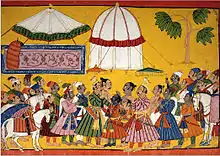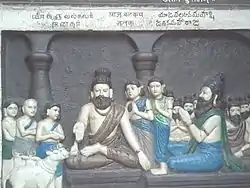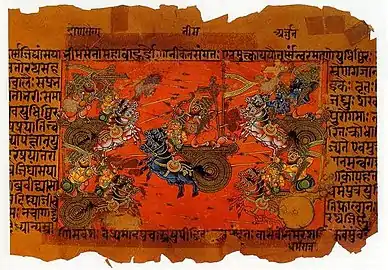Janaka
Janaka was an ancient Indian king of Videha which was located in Mithila region,.[1] The rulers of the Videha kingdom were called Janakas. He also appears in epic Ramayana as a father of Sita. His original name was Seeradhwaja and he had a brother named Kushadhwaja. His father's name was Hroshhoroma. King Nimi was the first ruler of the Videha kingdom. Then king Mithi supposed the name Mithila came after him. His son king Janaka(1st), was the first Janaka. Then after three successors came king Devraat and after Devraat the 15th successor was Hroshhoroma.
| Janaka | |
|---|---|
| Ramayana character | |
 | |
| In-universe information | |
| Spouse | Sunayana |
| Children | Sita, Urmila (Daughters) |
| Birth place | Videha Kingdom |
| Death place | Videha Kingdom |
Janaka is revered as being an ideal example of non-attachment to material possessions. He was intensely interested in spiritual discourse and considered himself free from worldly illusions. His interactions with sages and seekers such as Ashtavakra and Sulabha are recorded in ancient texts. His relationship with adopted daughter Sita led her to be called Janaki Mata. The city of Janakpur in Nepal is named for him and daughter Sita.[2] The Videha (or Mithila) kingdom was located between east of Gandaki River, west of Mahananda River, north of Ganga river and south of Himalayas.[3][4]
Janaka in Vedic literature
.png.webp)

Late Vedic literature such as Shatapatha Brahmana and Brihadaranyaka Upanishad mention a certain King Janaka (c. 8th or 7th century BCE) as a great philosopher-king of Videha, renowned for his patronage of Vedic culture and philosophy and whose court was an intellectual center for Brahmin sages such as Yajnavalkya, Uddalaka Aruni, and Gargi Vachaknavi.[1] Under his reign, Videha became a dominant political and cultural center of the Indian subcontinent.[5]
In other literature
Janaka is the father of Sita, the wife of God Ram in the Hindu epic Ramayana. His conversation with Ashtavakra is recorded as Ashtavakra Gita, wherein he is depicted as one realised and this tested by the sage Ashtavakra. Many spiritual teachers have referred to this writing often translating and deducing its meaning.[6][7]
Notes
References
Citations
- Raychaudhuri 2006, pp. 41–52.
- Raychaudhuri 2006, p. 44.
- Jha, M. (1997). "Hindu Kingdoms at contextual level". Anthropology of Ancient Hindu Kingdoms: A Study in Civilizational Perspective. New Delhi: M.D. Publications Pvt. Ltd. pp. 27–42. ISBN 9788175330344.
- Mishra, V. (1979). Cultural Heritage of Mithila. Allahabad: Mithila Prakasana. p. 13. Retrieved 28 December 2016.
- Michael Witzel (1989), Tracing the Vedic dialects in Dialectes Dans Les literatures Indo-Aryennes ed. Caillat, Paris, 97–265.
- Vanita, Ruth (2009). "Full of God:Ashtavakra and ideas of Justice in Hindu Text". Religions of South Asia. 3 (2). Retrieved 22 February 2017.
- Mukerjee, Radhakamal (1971). The song of the self supreme (Aṣṭāvakragītā): the classical text of Ātmādvaita by Aṣṭāvakra. Motilal Banarsidass Publ. ISBN 978-81-208-1367-0.
Sources
- Dictionary of Hindu Lord and Legend (ISBN 0-500-51088-1) by Anna Dhallapiccola
- Raychaudhuri, Hemchandra (2006), Political History of Ancient India, Cosmo Publications, ISBN 81-307-0291-6
.jpg.webp)

